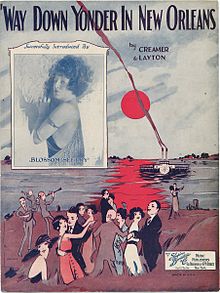Way Down Yonder in New Orleans
Way Down Yonder in New Orleans is a pop song written by Turner Layton (music) and Henry Creamer (lyrics); the song was released in 1922 and has become a jazz standard .
History and content of the song
Way Down Yonder in New Orleans was initially part of the Broadway revue Spice of 1922 , which was performed in the Winter Garden Theater in New York. In the song in the second act of the revue, a musician from New Orleans praises his hometown as " Garden of Eden " and as "Heaven here on earth."
The song is written in the song form A-A'-BCA ". The last A section is four bars shorter than the other A sections; each stanza therefore only comprises 28 bars.
Impact history
One of the first singers who interpreted Way Down Yonder in New Orleans was Blossom Seeley, whose photo was also reproduced on the cover of the music edition. Other early interpretations come from Frank Guarente, George Kelly , Paul Whiteman and (in London) Fred Elizalde . On May 13, 1927, Bix Beiderbecke recorded it ( Volume 1: Singin 'the Blues ), which is considered a “masterpiece” in jazz history.
Jimmy Noone recorded the title in 1936. In 1938 the Kansas City Six played the song; In addition to Lester Young (on tenor saxophone or clarinet ) and Buck Clayton , Eddie Durham played one of the "first solos in jazz history on the electric guitar ". In the same year, Bill Coleman immortalized his version of the song in Paris . Other recordings were made by The Andrews Sisters , Al Jolson , but also by Tommy Dorsey and Jimmy Dorsey , who both recorded the song in 1950 in a combo line-up . There are only a few big band recordings of the title, for example by Duke Ellington , Ray Noble and Claude Thornhill .
In the 1950s, after versions by Sharkey Bonano with his Kings of Dixieland and by Jimmy McPartland (1956), the European revival bands discovered the song: Chris Barber , Acker Bilk , the Düsseldorfer Feetwarmers or the Maryland Jazz Band of Cologne . The Dutch Swing College Band makes Way Down Yonder in New Orleans even their signature tune and recorded the song again and again.
The song also lives on in pop music . 1953 Frankie Laine and Jo Stafford took him on successfully; 1959 followed by Freddy Cannon , who reached number 3 on the Billboard charts with his version in 1960 .
Use in film
The song was first used in the film musical The Story of Vernon and Irene Castle (1937), but only as part of a medley . In 1951 he appeared in Somebody Loves Me ; it was also used in a big band version for the soundtrack of the Gene Krupa story in 1959 .
literature
- Dietrich Schulz-Köhn , The Evergreen Story: 40 x Jazz Quadriga, Weinheim, Berlin 1990, ISBN 3-88679-188-2
Individual evidence
- ↑ Brief portrait (jazzstandards.com)
- ^ Internet Broadway Database
- ↑ D. Schulz-Köhn The Evergreen Story , p. 320
- ^ A b D. Schulz-Köhn The Evergreen Story , p. 322
- ↑ Katherine Blossom Seeley (1885–1974)
- ↑ D. Schulz-Köhn The Evergreen Story , p. 320. James L. Collier characterized in his book The Making of Jazz : "One can almost hear Bix think."
- ↑ D. Schulz-Köhn The Evergreen Story , p. 323
- ↑ cf. D. Schulz-Köhn The Evergreen Story , p. 323ff.
- ^ Whitburn, Joel: Top Pop Singles 1955-1993 . Menomonee Falls, Wisconsin: Record Research Ltd., 1994, p. 87
